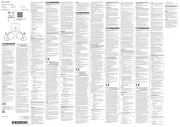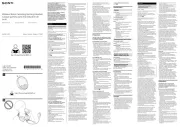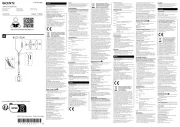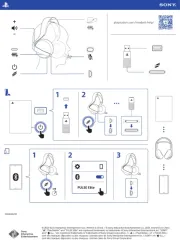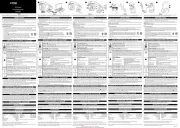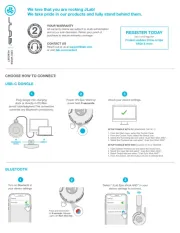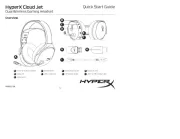
Wireless Noise Canceling Gaming Headset
Casque gaming sans fil à réduction de
bruit
Reference Guide Guide de référence Guía de referencia
INZONE H9 II Model, Modèle, Modelo: YY2987
https://rd1.sony.net/help/mdr/2987/h_zz/
5-067-255-11(1)
©2025 Sony Corporation
Printed in China
Imprimé en Chine
https://rd1.sony.net/help/mdr/2987/h_zz/
FOR CUSTOMERS IN CANADA (INCLUDING IN
THE PROVINCE OF QUEBEC)
ALL INSTRUCTIONS AND STATEMENTS WHICH
ARE NECESSARY FOR CANADIAN CUSTOMERS
ARE PROVIDED IN ENGLISH AND FRENCH. OTHER
INSTRUCTIONS AND STATEMENTS NOT
PROVIDED IN ENGLISH AND FRENCH ARE NOT
FOR CANADIAN CUSTOMERS (INCLUDING IN THE
PROVINCE OF QUEBEC).
POUR LES CLIENTS AU CANADA (Y COMPRIS
DANS LA PROVINCE DE QUÉBEC)
TOUTES LES INSTRUCTIONS ET DÉCLARATIONS
NÉCESSAIRES POUR LES CLIENTS CANADIENS
SONT FOURNIES EN ANGLAIS ET EN FRANÇAIS.
LES AUTRES INSTRUCTIONS ET ÉNONCÉS NON
FOURNIS EN ANGLAIS ET EN FRANÇAIS NE SONT
PAS DESTINÉS AUX CLIENTS CANADIENS (Y
COMPRIS AU QUÉBEC).
English
Wireless Noise Canceling Gaming
Headset
Model: YY2987
The term “product” in this document refers to the
unit or its accessories.
FOR UNITED STATES CUSTOMERS. NOT
APPLICABLE IN CANADA, INCLUDING IN THE
PROVINCE OF QUEBEC.
POUR LES CONSOMMATEURS AUX
ÉTATS-UNIS. NON APPLICABLE AU CANADA,
Y COMPRIS LA PROVINCE DE QUÉBEC.
Owner’s Record
Record the model and serial numbers in the
spaces provided below and store them safely.
Refer to them whenever you call your Sony
dealer regarding this product.
Model No.________________________
Serial No._________________________
The model and serial numbers to be recorded
are located in the following places.
• See Fig.
The nameplate and important information
concerning safety are attached in the following
locations:
See Fig.
Do not install the product in a confined space,
such as a bookcase or built-in cabinet.
Do not expose the batteries (battery pack or
batteries installed) to excessive heat, such as
sunshine, fire or the like, for a long time.
Do not subject the batteries to extreme low
temperature conditions that may result in
overheating and thermal runaway.
Do not dismantle, open, or shred secondary
batteries.
In the event of a secondary battery leaking, do
not allow the liquid to come in contact with the
skin or eyes. If contact has been made, wash the
affected area with copious amounts of water and
seek medical advice.
Secondary batteries need to be charged before
use. Always refer to the manufacturer’s
instructions or product manual for proper
charging instructions.
After extended periods of storage, it may be
necessary to charge and discharge the
secondary batteries several times to obtain
maximum performance.
Dispose of properly.
Charging this unit
Use the supplied USB Type-C® cable and a
commercially available USB AC adaptor.
Connect the USB AC adaptor to this unit using
the USB Type-C cable, then connect the USB AC
adaptor to an AC outlet.
DISPOSAL OF RECHARGEABLE BATTERIES
You can help preserve our environment by
returning your used rechargeable batteries to the
collection and recycling location nearest you.
For more information regarding recycling of
rechargeable batteries, visit
www.sony.com/ecotrade
Caution: Do not handle damaged or leaking
rechargeable batteries.
FOR UNITED STATES CUSTOMERS. NOT
APPLICABLE IN CANADA, INCLUDING IN THE
PROVINCE OF QUEBEC.
POUR LES CONSOMMATEURS AUX
ÉTATS-UNIS. NON APPLICABLE AU CANADA,
Y COMPRIS LA PROVINCE DE QUÉBEC.
You are cautioned that any changes or
modifications not expressly approved in this
manual could void your authority to operate
this unit.
If you have any questions about this
product:
Visit: https://www.sony.com/electronics/
support
Contact: Sony Customer Information Service
Center at 1-800-222-7669
Supplier’s Declaration of Conformity
Trade Name: SONY
Model: YY2987
Responsible Party: Sony Electronics Inc.
Address: 16535 Via Esprillo, San Diego, CA
92127 U.S.A.
Telephone Number: 858-942-2230
This device complies with part 15 of the FCC
Rules. Operation is subject to the following
two conditions:
(1) This device may not cause harmful
interference, and
(2) this device must accept any interference
received, including interference that may
cause undesired operation.
NOTE:
This unit has been tested and found to
comply with the limits for a Class B digital
device, pursuant to Part 15 of the FCC Rules.
These limits are designed to provide
reasonable protection against harmful
interference in a residential installation. This
unit generates, uses, and can radiate radio
frequency energy and, if not installed and
used in accordance with the instructions, may
cause harmful interference to radio
communications.
However, there is no guarantee that
interference will not occur in a particular
installation. If this unit does cause harmful
interference to radio or television reception,
which can be determined by turning the unit
off and on, the user is encouraged to try to
correct the interference by one or more of the
following measures:
• Reorient or relocate the receiving antenna.
• Increase the separation between the unit
and receiver.
• Connect the unit into an outlet on a circuit
different from that to which the receiver is
connected.
• Consult the dealer or an experienced radio/
TV technician for help.
This unit must not be co-located or operated
in conjunction with any other antenna or
transmitter.
For customers in Canada
This unit contains licence-exempt
transmitter(s)/receiver(s) that comply with
Innovation, Science and Economic
Development Canada’s licence-exempt
RSS(s). Operation is subject to the following
two conditions:
(1) This unit may not cause interference; and
(2) This unit must accept any interference,
including interference that may cause
undesired operation of the unit.
The available scientific evidence does not show
that any health problems are associated with
using low power wireless devices. There is no
proof, however, that these low power wireless
devices are absolutely safe. Low power wireless
devices emit low levels of radio frequency energy
(RF) in the microwave range while being used.
Whereas high levels of RF can produce health
effects (by heating tissue), exposure of low-level
RF that does not produce heating effects causes
no known adverse health effects. Many studies
of low-level RF exposures have not found any
biological effects. Some studies have suggested
that some biological effects might occur, but
such findings have not been confirmed by
additional research. These units have been
tested and found to comply with FCC/ISED
radiation exposure limits set forth for an
uncontrolled environment and meet the FCC
radio frequency (RF) Exposure Guidelines and
RSS-102 of the ISED radio frequency (RF)
Exposure rules.
High volume may adversely affect your hearing.
Do not use the unit while walking, driving, or
cycling. Doing so may cause traffic accidents.
Do not use in hazardous areas unless the
surrounding sound can be heard.
The unit is not waterproof. If water or foreign
matter enters the unit, it may result in fire or
electric shock. If water or foreign matter enters
the unit, stop use immediately and consult your
nearest Sony dealer. In particular, be careful in
the following cases.
• When using the unit near a sink or liquid
container
Be careful that the unit does not fall into a sink
or container filled with water.
• When using the unit in the rain or snow, or in
humid locations
• When using the unit while you are perspiring
If you touch the unit with wet hands, or put the
unit in the pocket of a damp article of clothing,
the unit may get wet.
For details on the effects of contact with the
human body from the mobile phone or other
wireless devices connected to the unit, refer to
the instruction manual of the wireless device.
Never insert the USB plug when the unit or
charging cable is wet. If the USB plug is inserted
while the unit or charging cable is wet, a short
circuit may occur due to liquid (tap water,
seawater, soft drink, etc.) or foreign matter on
the unit or charging cable, and cause abnormal
heat generation or malfunction.
This product has magnet(s) which may interfere
with pacemakers, programmable shunt valves for
hydrocephalus treatment, or other medical
devices. Do not place this product close to
persons who use such medical devices. Consult
your doctor before using this product if you use
any such medical device.
There is a danger that small parts may be
swallowed. After use, store in a location out of
reach of small children.
Note about static electricity
If you use the unit when the air is dry, you may
experience discomfort due to static electricity
accumulated on your body. This is not a
malfunction of the unit. You can reduce the
effect by wearing clothes made of natural
materials that do not easily generate static
electricity.
IMPORTANT
The factory default setting of the voice guidance
for this unit is English.
The voice guidance can be heard from the unit in
the following situations:
• When the remaining battery level is low and
recharge is recommended: “Low battery”
• When automatically turning off due to low
battery: “Battery is empty”
• When checking the remaining battery level:
“Battery fully charged” / “Battery about 70%” /
“Battery about 50%” / “Battery about 20%”
• When entering pairing mode: “Pairing”
• When the USB cable is connected to the
headset and a charging error or temperature
error occurs during use: “Charging stopped. To
resume charging, disconnect the USB cable and
wait before trying again”
Precautions
The URL on the cover will help you access
the help guide that describes useful notes
or procedures in details.
On BLUETOOTH® communications
• Microwaves emitting from a Bluetooth device
may affect the operation of electronic medical
devices. Turn off this unit and other Bluetooth
devices in the following locations, as it may
cause an accident:
– in hospitals, near priority seating in trains,
locations where inflammable gas is present,
near automatic doors, or near fire alarms.
• The audio playback on this unit may be
delayed from that on the transmitting device,
due to the characteristics of Bluetooth wireless
technology. As a result, the sound may not be
in sync with the image when viewing movies or
playing games.
On charging the unit
• Be sure to use the supplied USB Type-C cable.
• After charging is complete, disconnect the USB
Type-C cable.
• While connecting the USB cable, do not apply
excessive force to the connection part.
• When connecting or disconnecting the USB
cable, do not apply excessive force, such as by
pulling the cable, and connect or disconnect
the connector straight to the port to be
connected.
• If the USB cable connector is deformed, such as
by it being bent, stop use immediately.
On using the unit while charging
• While liquid such as water or sweat, or foreign
matter such as dust is attached to the USB
Type-C cable or USB port, charging the unit
may cause serious accidents such as burns or
injuries due to fire, electric shock, heat
generation or ignition, or can be the cause of a
malfunction.
Note the following when you use the unit while
charging.
– If you feel any abnormality, stop using
immediately.
– Check that there is no dust or foreign matter
inside.
– If the USB cable or port gets wet due to liquid
such as drinking water or sweat while
charging, disconnect the USB cable from the
connected device immediately to stop
charging (Fig.).
Notes on wearing the unit
• After use, remove the headphones slowly.
• Because the headphones achieve a tight seal
over the ears, forcibly pressing them against
your ears or quickly pulling them off can result
in eardrum damage. When wearing the
headphones, the speaker diaphragm may
produce a click sound. This is not a
malfunction.
Other notes
• When you use the unit as wired headphones,
use the supplied headphone cable only. Make
sure that the headphone cable is firmly
inserted.
• When disconnecting the cable, pull it out by
the plug, not the cable. Otherwise the cable
may break.
• When connecting the cable, make sure to fully
insert the plug into the jack. If the plug is not
fully inserted, the sound may not be output.
• Do not subject the unit to excessive shock.
• Do not apply weight or pressure to the unit for
long periods, including when it is stored, as it
may cause deformation.
• If you experience discomfort while using the
unit, stop using it immediately.
• Be careful that the boom microphone does not
hit your eyes while wearing, removing, and
using the unit.
• If you have any questions or problems
concerning this unit that are not covered in this
manual, please consult your nearest Sony
dealer.
Location of the serial number label
See Fig.
Specifications
Headset
Power source:
DC 5 V (Using a commercially available USB
AC Adaptor)
Using built-in lithium-ion batteries (Product
Operation Power: DC 3.85 V)
Operating temperature:
0 °C to 40 °C (32 °F to 104 °F)
Rated power consumption:
2.5 W
Mass:
Approx. 260 g (9.18 oz) (Headset (without
microphone))
Approx. 3.2 g (0.12 oz) (USB Type-C®
transceiver)
Approx. 13 g (0.46 oz) (Detachable boom
microphone (with windscreen))
Included items:
Wireless Noise Canceling Gaming Headset
(1)
USB Type-C® cable (USB-A to USB-C®) (1)
Headphone cable (1)
Detachable boom microphone (with
windscreen) (1)
Soft pouch (1)
USB Type-C® transceiver: YY2988 (1)
Documents (1 set)
Communication specification
Communication system:
Bluetooth Specification version 5.3
Output:
Bluetooth Specification Power Class 1
Frequency band:
Bluetooth: 2.4 GHz band (2.400 0 GHz -
2.483 5 GHz)
Wireless Transmitter Receiver Section:
2.4GHz band (2.400 0 GHz - 2.483 5 GHz)
Design and specifications are subject to change
without notice.
System requirements for
battery charge using USB
USB AC adaptor:
A commercially available USB AC adaptor
capable of supplying an output current of 0.5A
(500mA) or more.
• Do not use a USB adaptor that exceeds the
maximum output of 13W (5V, 2.6A).
Recommended Personal
Computer OS version
Windows®: Windows 10 or later
Mac: macOS 13 or later
Trademarks
• macOS and Mac are trademarks of Apple Inc.,
registered in the U.S. and other countries and
regions.
• Microsoft and Windows are registered
trademarks or trademarks of Microsoft
Corporation in the United States and/or other
countries.
• The Bluetooth® word mark and logos are
registered trademarks owned by Bluetooth SIG,
Inc. and any use of such marks by Sony Group
Corporation and its subsidiaries is under
license.
• USB Type-C® and USB-C® are registered
trademarks of USB Implementers Forum.
• Sony and INZONE are registered trademarks or
trademarks of Sony Group Corporation or its
affiliates.
• All other trademarks and registered trademarks
are trademarks or registered trademarks of
their respective holders. In this manual, ™ and
® marks are not specified.
Licenses
• This product contains software that Sony uses
under a licensing agreement with the owner of
its copyright. We are obligated to announce the
contents of the agreement to customers under
requirement by the owner of copyright for the
software. Please access the following URL and
read the contents of the license.
https://rd1.sony.net/help/mdr/sl/25/
• Services offered by third parties may be
changed, suspended, or terminated without
prior notice. Sony does not bear any
responsibility in these sorts of situations.
Français
Casque gaming sans fil à
réduction de bruit
Modèle : YY2987
Le terme «produit» dans ce document désigne
l’appareil ou ses accessoires.
La plaque signalétique et les informations
importantes concernant la sécurité sont fixées
aux endroits suivants :
Voir la figure
N’installez pas le produit dans un espace clos,
comme une bibliothèque ou une armoire
encastrée.
N’exposez pas les piles (bloc-batterie ou piles
installées) à une chaleur excessive, telle que le
soleil, un feu ou autre, pendant une longue
période.
Ne soumettez pas les batteries à des conditions
de température extrêmement basses qui
pourraient entraîner une surchauffe et un
emballement thermique.
Ne démontez pas, n’ouvrez pas et ne détruisez
pas les batteries rechargeables.
En cas de fuite d’une batterie rechargeable, ne
laissez pas le liquide entrer en contact avec la
peau ou les yeux. Si un contact a été établi, lavez
la zone touchée avec de grandes quantités d’eau
et consultez un médecin.
Les batteries rechargeables doivent être
chargées avant d’être utilisées. Reportez-vous
toujours aux instructions du fabricant ou au
manuel du produit pour obtenir des instructions
de chargement pertinentes.
Après de longues périodes de stockage, il peut
être nécessaire de charger et de décharger les
batteries rechargeables plusieurs fois pour
obtenir une performance maximale.
Mettez au rebut correctement.
Chargement de l’appareil
Utilisez le câble USB Type-C® fourni et un
adaptateur CA USB disponible dans le commerce.
Branchez l’adaptateur CA USB à l’appareil à l’aide
du câble USB Type-C, puis branchez l’adaptateur
CA USB à une prise secteur.
MISE AU REBUT DES ACCUMULATEURS
RECHARGEABLES
Vous pouvez aider à préserver l’environnement
en rapportant les accumulateurs usagées dans
un point de collection et recyclage le plus proche
de chez vous.
Pour plus d’informations sur le recyclage des
accumulateurs, visitez
www.sony.com/ecotrade
Avertissement : Ne pas utiliser des
accumulateurs rechargeables qui sont
endommagées ou qui fuient.
Pour les clients au Canada
L’émetteur/récepteur exempt de licence
contenu dans la présente unité est conforme
aux CNR d’Innovation, Sciences et
Développement économique Canada
applicables aux deux conditions suivantes :
1) l’unité ne doit pas produire de brouillage ;
2) l’utilisateur de l’unité doit accepter tout
brouillage radioélectrique subi, même si le
brouillage est susceptible d’en compromettre
le fonctionnement.
Les connaissances scientifiques dont nous
disposons n’ont mis en évidence aucun
problème de santé associé à l’usage des
appareils sans fil à faible puissance. Nous ne
sommes cependant pas en mesure de prouver
que ces appareils sans fil à faible puissance sont
entièrement sans danger. Les appareils sans fil à
faible puissance émettent une énergie fréquence
radioélectrique (RF) très faible dans le spectre
des micro-ondes lorsqu’ils sont utilisés. Alors
qu’une dose élevée de RF peut avoir des effets
sur la santé (en chauffant les tissus), l’exposition
à de faibles RF qui ne produisent pas de chaleur
n’a pas de mauvais effets connus sur la santé. De
nombreuses études ont été menées sur les
expositions aux RF faibles et n’ont découvert
aucun effet biologique. Certaines études ont
suggéré qu’il pouvait y avoir certains effets
biologiques, mais ces résultats n’ont pas été
confirmés par des recherches supplémentaires.
Ces appareils ont été testés et jugés conformes
aux limites d’exposition aux rayonnements
énoncées pour un environnement non contrôlé
et respectent les règles les radioélectriques (RF)
de la FCC lignes directrices d’exposition et
d’exposition aux fréquences radioélectriques (RF)
CNR-102 de l’ISDE.
Un volume élevé peut nuire à votre audition.
N’utilisez pas l’appareil lorsque vous marchez,
conduisez ou faites du vélo. Cela pourrait
provoquer des accidents de la circulation.
N’utilisez pas l’appareil dans des zones
dangereuses à moins que les bruits environnants
puissent être entendus.
L’appareil n’est pas étanche. Si de l’eau ou des
corps étrangers pénètrent dans l’appareil, cela
pourrait provoquer un incendie ou un choc
électrique. Si de l’eau ou un corps étranger
pénètre dans l’appareil, cessez immédiatement
de l’utiliser, puis consultez votre revendeur Sony
le plus proche. En particulier, faites attention
dans les cas suivants :
• Lors de l’utilisation à côté d’un évier ou d’un
récipient de liquide
Veillez à ce que l’appareil ne tombe pas dans
un évier ou un récipient rempli d’eau.
• Lors de l’utilisation sous la pluie, la neige ou
dans des lieux humides
• Lors de l’utilisation en cas de transpiration
Si vous touchez l’appareil avec des mains
mouillées ou si vous rangez l’appareil dans la
poche d’un vêtement humide, il pourra être
mouillé également.
Pour plus de détails sur les effets du contact
entre le corps humain et le téléphone mobile ou
d’autres périphériques sans fil connectés à
l’appareil, reportez-vous au mode d’emploi du
périphérique sans fil.
N’insérez jamais la fiche USB lorsque l’appareil
ou le câble de charge est humide. Si vous insérez
la fiche USB quand l’appareil ou le câble de
charge est humide, vous risquez de provoquer
un court-circuit à cause du liquide (eau du
robinet, eau de mer, soda, etc.) ou de la présence
d’un corps étranger sur l’appareil ou le câble de
charge, ce qui génère une chaleur anormale ou
un dysfonctionnement.
Ce produit est doté d’un ou plusieurs aimants
qui peuvent interférer avec le fonctionnement
des stimulateurs cardiaques, robinets de
dérivation programmables pour traitement
d’hydrocéphalie ou autres appareils médicaux.
Ne placez pas ce produit près des personnes qui
utilisent de tels appareils médicaux. Consultez
votre médecin avant d’utiliser ce produit si vous
utilisez de tels appareils médicaux.
Les petites pièces présentent un risque
d’ingestion. Après utilisation, entreposez
l’appareil dans un lieu hors de portée des
enfants en bas âge.
Remarque concernant l’électricité statique
Si vous utilisez l’appareil lorsque l’air est sec,
vous pouvez ressentir une gêne due à l’électricité
statique accumulée sur votre corps. Il ne s’agit
pas d’un dysfonctionnement de l’appareil. Vous
pouvez réduire cet effet en portant des
vêtements en matériaux naturels qui ne
génèrent pas facilement d’électricité statique.
IMPORTANT
Le réglage d’usine par défaut du guidage vocal
pour cet appareil est l’anglais.
Le guidage vocal peut se faire entendre en
provenance de l’appareil dans les situations
suivantes :
• Lorsque le niveau restant de la batterie est
faible et qu’une recharge est recommandée :
«Low battery» (Batterie faible)
• Lors de la mise en arrêt automatique en raison
de la batterie faible : «Battery is empty» (La
batterie est vide)
• Lors de la vérification du niveau restant de la
batterie: «Battery fully charged» / «Battery
about 70%» / «Battery about 50%» / «Battery
about 20%» (Batterie entièrement chargée /
Batterie environ 70% / Batterie environ 50% /
Batterie environ 20%)
• Lorsque l’appareil passe en mode de
jumelage: «Pairing» (Jumelage)
• Quand le câble USB est raccordé au casque
d’écoute et qu’une erreur de recharge ou une
erreur de température se produit pendant
l’utilisation : « Charging stopped. To resume
charging, disconnect the USB cable and wait
before trying again » (La recharge s’est arrêtée.
Pour reprendre la recharge, débranchez le
câble USB et attendez avant de réessayer.)
Précautions
L’URL figurant sur le couvercle vous
permet d’accéder au guide d’aide qui
contient des remarques utiles et décrit les
procédures en détail.
Sur les communications BLUETOOTH®
• Les micro-ondes émises par tout appareil
Bluetooth peuvent affecter le fonctionnement
des dispositifs médicaux électroniques.
Éteignez le dispositif et tout autre appareil
Bluetooth dans les lieux suivants afin d’éviter
tout accident :
– dans les hôpitaux, à proximité des sièges
prioritaires de train, des endroits accueillant
tout gaz inflammable, ainsi que près des
alarmes incendie ou des portes
automatiques.
• La lecture audio sur ce dispositif peut être
différée par rapport à celle de tout appareil
émetteur, en raison des caractéristiques de la
technologie sans fil Bluetooth. Par conséquent,
il se peut que l’audio ne soit pas synchronisé
avec l’image de vos films ou jeux vidéo.
Chargement du dispositif
• Assurez-vous d’utiliser le câble USB Type-C
fourni.
• Une fois le chargement terminé, déconnectez
le câble USB Type-C.
• Lors de la connexion du câble USB, n’appliquez
pas de force excessive au niveau de la pièce de
connexion.
• Lors de la connexion ou de la déconnexion du
câble USB, n’appliquez pas une force excessive,
par exemple en tirant le câble, et connectez ou
déconnectez le connecteur directement du port
à connecter.
• Si le connecteur du câble USB est déformé, par
exemple plié, arrêtez immédiatement
l’utilisation.

